The Latin America Automotive HVAC Market is estimated to be valued at USD 8.4 billion in 2025 and is projected to reach USD 13.2 billion by 2035, registering a compound annual growth rate (CAGR) of 4.6% over the forecast period.
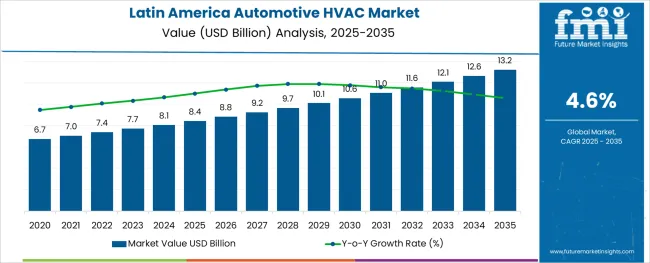
The Latin America automotive HVAC market is experiencing steady growth, supported by rising demand for thermal comfort, technological advancement in climate control systems, and growing penetration of passenger vehicles across urbanizing economies. Automakers are increasingly adopting energy-efficient and environment-friendly HVAC technologies to comply with regional emissions regulations and evolving fuel economy standards.
The integration of HVAC with vehicle electronic architectures, including infotainment and telematics systems, is transforming these systems from standalone units into smart, responsive components. Demand for advanced comfort features is expanding beyond premium models, driven by growing middle-class consumer spending and competitive differentiation among OEMs. The market is expected to benefit from future developments in electric vehicle thermal management and zonal climate control, alongside broader adoption of connected vehicle platforms.
Strategic localization of manufacturing and increasing investments in component standardization are further contributing to growth opportunities across the region.
The market is segmented by Technology Type and Vehicle Type and region. By Technology Type, the market is divided into Automatic HVAC System and Manual HVAC System. In terms of Vehicle Type, the market is classified into Passenger Vehicle and Commercial Vehicle. Regionally, the market is classified into North America, Latin America, Western Europe, Eastern Europe, Balkan & Baltic Countries, Russia & Belarus, Central Asia, East Asia, South Asia & Pacific, and the Middle East & Africa.
The market is segmented by Technology Type and Vehicle Type and region. By Technology Type, the market is divided into Automatic HVAC System and Manual HVAC System. In terms of Vehicle Type, the market is classified into Passenger Vehicle and Commercial Vehicle. Regionally, the market is classified into North America, Latin America, Western Europe, Eastern Europe, Balkan & Baltic Countries, Russia & Belarus, Central Asia, East Asia, South Asia & Pacific, and the Middle East & Africa.
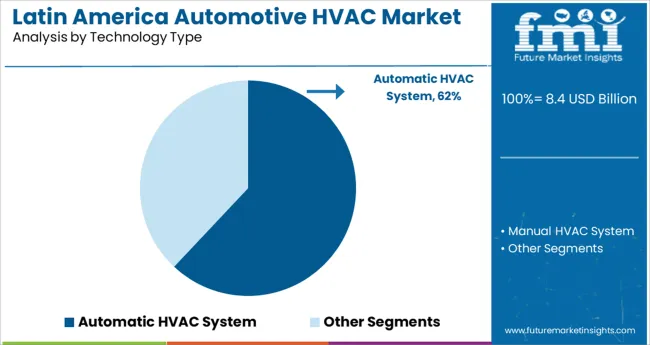
Automatic HVAC systems are projected to account for 62.0% of the total revenue share in the Latin America automotive HVAC market by 2025, making it the dominant technology segment. This segment's leadership is being driven by increasing demand for intelligent and energy-efficient climate control solutions that adjust airflow, temperature, and humidity autonomously.
Enhanced passenger comfort, minimized driver distraction, and improved fuel economy have made automatic HVAC systems a preferred choice across both premium and mid-range vehicle categories. Advancements in sensor technology, integration with vehicle ECUs, and smart thermostatic controls have further elevated the value proposition of automatic systems. As consumers prioritize convenience and climate personalization, OEMs are equipping more vehicles with automatic HVAC systems as standard features.
The growing influence of digital interfaces and AI-driven cabin control will further support adoption, positioning automatic HVAC systems as essential in future-ready vehicle architectures.
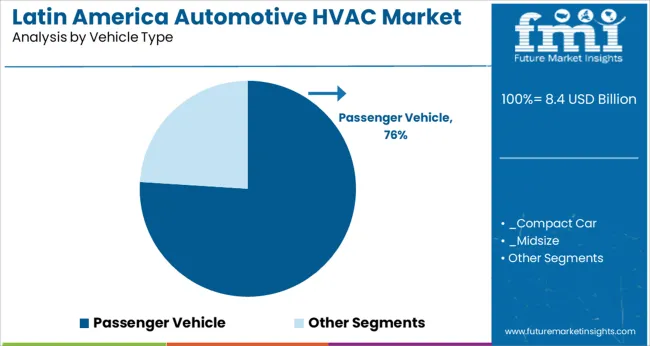
Passenger vehicles are expected to contribute 76.0% of the total revenue share in the Latin America automotive HVAC market in 2025, establishing them as the leading vehicle type segment. This dominance is being driven by increasing sales of sedans, hatchbacks, and SUVs across both emerging urban centers and developed regions of Latin America. Rising consumer awareness of cabin air quality, in-cabin temperature control, and automotive comfort features is fueling demand for HVAC integration in all passenger vehicle categories.
Regulatory frameworks related to air conditioning performance and energy efficiency have also played a role in standardizing HVAC installations. Additionally, rising vehicle production and increased penetration of compact and mid-size cars-especially in Brazil, Mexico, and Argentina-are reinforcing this segment’s leadership.
As personal mobility preferences shift and OEMs focus on enhancing comfort and safety, HVAC adoption in passenger vehicles is expected to remain high, supporting long-term segmental growth.
The analysis of automotive HVAC demand from 2020 to 2024 exhibited a deflated growth rate of under 1% CAGR. Latin America region is facing challenges relating to commodity price rise, electronics, components, and other raw material import dependency over North America and China is further restraining growth prospects in Automotive Industry.
In developing countries where a lot of agricultural output or mining occurs, growth in demand for passenger and commercial vehicle fleets may offer further incentives for more investments in automotive HVAC equipment.
However, due to infection curves flattening as of 2025, industrial production activity has restarted in emerging markets. As a result, the market for automotive HVAC systems in Latin America is expected to grow at a CAGR of 4.6% by 2035.
The primary factors driving the Latin American automotive air-conditioning market are the growth of the automotive industry, rising demand for high-tech features in cars, and increasing development of cabin comfort features by automobile manufacturers.
The market for heating, ventilation and air conditioning (HVAC) equipment may be growing as stakeholders, such as governments and NGOs, are promoting energy-efficient technologies. As environmental consciousness has increased in emerging economies as well as developed nations, there has been a clear trend toward the installation and utilization of more green-labeled products. For instance, significant companies have increased their investments in solar-based HVAC systems, including Daikin Industries, Ltd. and Lennox International Inc.
The demand for concepts that are incorporated with autonomous climate control and thermal management systems to the provision of automobiles is driving the demand for automobiles in Latin America's automotive HVAC systems market. Automotive HVAC systems provide a marketplace differentiator in response to vehicles' luxury quotient. A number of the most important development areas of this market are enhancing fuel efficiency and maintaining the quality of our environment.
The heating, ventilation and cooling business is growing, as the temperatures are getting more extreme and the climate is getting unstable. There are several key challenges to this business's development, with the biggest being high business start-up expenses and fierce competition. The players in the industry are engaged in fierce competition, which is leading to important advancements and achieving more compact, efficient, and effective hardware.
The noise created by these systems within the cabin of a driver's vehicle, making the passengers uneasy, is one of the reasons that the automotive HVAC market faces challenges. These systems' interactions with the airflow and HVAC parts create clanging noises. Currently, HVAC manufacturers incorporate passive absorbers into their designs to reduce heat flowing through the system. Considering the current expectations of customers for rapid service and a long lifespan from automotive systems, it is essential to preserve your clients and market position in the highly competitive automotive HVAC sector.
The market expansion of HVAC tools has been reduced sharply by the surge in the costs for raw materials and parts, including cooling panels. The intense competition has resulted in some HVAC companies selling their products for a cheap price. Additional barriers to entry for new companies include a lack of skilled personnel and expensive start-up costs.
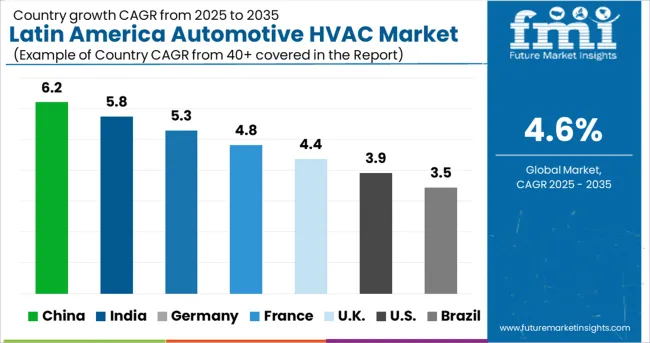
The Latin American passenger automobile market is currently recovering following the effects of the severe devaluation of currencies and fiscal catastrophes in parts of the region. The Mexican and Brazilian markets play a central role in turning out their output, exports, and sales.
It is expected that, during the projection period, Brazil will maintain a position of dominance in the automobile air conditioning segment of the passenger vehicle industry, whereas Mexico will grow its leading position in the compartment for the transportation industry.
Due to rising consumer demand and sales as well as government measures for the quick development of the automotive component sector, Brazil's automotive HVAC market is anticipated to maintain its leadership for the coming years with a substantial CAGR.
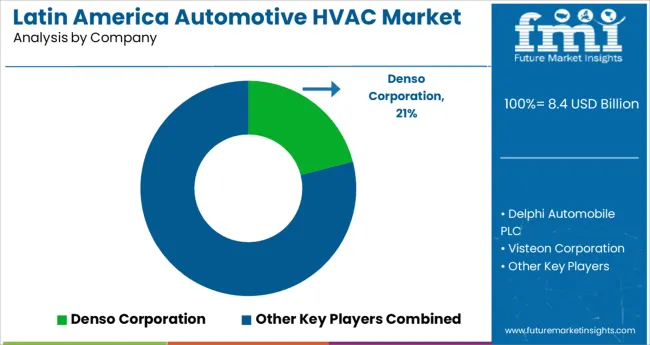
Halla Visteon Climate Control Corp. recently opened a new production plant in the Brazilian state of Sao Paulo, Atibaia, to facilitate localization and improve customer service. Denso Corporation, Delphi Automobile PLC, Visteon Corporation, Valeo SA, and Behr GmbH & Co. Kg are the key participants in the Latin American automotive HVAC market.
Most of the companies in the automotive HVAC market have built significant financial investments in extensive research and development, primarily to produce new and developed products. Product development, mergers, and acquisitions are the business strategies used by the major companies in the automotive HVAC market.
These market participants also engage in new developments and product launches, along with mergers, acquisitions, and collaborations while obtaining regulatory permission.
| Attribute | Details |
|---|---|
| Growth Rate | CAGR of 4.6% from 2025 to 2035 |
| Base Year for Estimation | 2024 |
| Historical Data | 2020 to 2024 |
| Forecast Period | 2025 to 2035 |
| Quantitative Units | Revenue in USD Million, Volume in Units, and CAGR from 2025 to 2035 |
| Report Coverage | Revenue Forecast, Volume Forecast, Company Ranking, Competitive Landscape, Growth Factors, Trends, and Pricing Analysis |
| Segments Covered |
Technology Type, Vehicle Type, Country |
| Key Countries Covered |
Argentina, Brazil, Mexico, Rest of Latin America |
| Key Companies Profiled |
Halla Visteon Climate Control Corp.; Denso Corporation; Delphi Automobile PLC; Visteon Corporation; Valeo SA; Behr GmbH & Co. Kg; Johnson Controls International plc; United Technologies Corporation; Ingersoll-Rand plc; Daikin Industries Ltd; Mitsubishi Electric Corporation |
| Customization & Pricing | Available upon Request |
The global latin america automotive hvac market is estimated to be valued at USD 8.4 billion in 2025.
It is projected to reach USD 13.2 billion by 2035.
The market is expected to grow at a 4.6% CAGR between 2025 and 2035.
The key product types are automatic hvac system and manual hvac system.
passenger vehicle segment is expected to dominate with a 76.0% industry share in 2025.






Our Research Products

The "Full Research Suite" delivers actionable market intel, deep dives on markets or technologies, so clients act faster, cut risk, and unlock growth.

The Leaderboard benchmarks and ranks top vendors, classifying them as Established Leaders, Leading Challengers, or Disruptors & Challengers.

Locates where complements amplify value and substitutes erode it, forecasting net impact by horizon

We deliver granular, decision-grade intel: market sizing, 5-year forecasts, pricing, adoption, usage, revenue, and operational KPIs—plus competitor tracking, regulation, and value chains—across 60 countries broadly.

Spot the shifts before they hit your P&L. We track inflection points, adoption curves, pricing moves, and ecosystem plays to show where demand is heading, why it is changing, and what to do next across high-growth markets and disruptive tech

Real-time reads of user behavior. We track shifting priorities, perceptions of today’s and next-gen services, and provider experience, then pace how fast tech moves from trial to adoption, blending buyer, consumer, and channel inputs with social signals (#WhySwitch, #UX).

Partner with our analyst team to build a custom report designed around your business priorities. From analysing market trends to assessing competitors or crafting bespoke datasets, we tailor insights to your needs.
Supplier Intelligence
Discovery & Profiling
Capacity & Footprint
Performance & Risk
Compliance & Governance
Commercial Readiness
Who Supplies Whom
Scorecards & Shortlists
Playbooks & Docs
Category Intelligence
Definition & Scope
Demand & Use Cases
Cost Drivers
Market Structure
Supply Chain Map
Trade & Policy
Operating Norms
Deliverables
Buyer Intelligence
Account Basics
Spend & Scope
Procurement Model
Vendor Requirements
Terms & Policies
Entry Strategy
Pain Points & Triggers
Outputs
Pricing Analysis
Benchmarks
Trends
Should-Cost
Indexation
Landed Cost
Commercial Terms
Deliverables
Brand Analysis
Positioning & Value Prop
Share & Presence
Customer Evidence
Go-to-Market
Digital & Reputation
Compliance & Trust
KPIs & Gaps
Outputs
Full Research Suite comprises of:
Market outlook & trends analysis
Interviews & case studies
Strategic recommendations
Vendor profiles & capabilities analysis
5-year forecasts
8 regions and 60+ country-level data splits
Market segment data splits
12 months of continuous data updates
DELIVERED AS:
PDF EXCEL ONLINE
Latin America Joint Compound Industry Analysis Size and Share Forecast Outlook 2025 to 2035
Latin America In-mold Labels Market Size and Share Forecast Outlook 2025 to 2035
Latin America Rigid Industrial Packaging Market Size and Share Forecast Outlook 2025 to 2035
Latin America Hand Sanitizer Market Size and Share Forecast Outlook 2025 to 2035
Latin America Hand Soap Market Size and Share Forecast Outlook 2025 to 2035
Latin America Hydraulic Filtration Market Size and Share Forecast Outlook 2025 to 2035
Latin America Frozen Ready Meals Market Insights – Demand & Forecast 2025–2035
Latin America Fish Protein Market Trends – Size, Growth & Forecast 2025–2035
Latin America Aqua Feed Additives Market Trends – Growth & Forecast 2025–2035
Latin America Collagen Peptide Market Report – Trends, Size & Forecast 2025–2035
Latin America Bubble Tea Market Outlook – Growth, Trends & Forecast 2025–2035
Latin America Shrimp Market Report – Trends, Growth & Forecast 2025–2035
Latin America Animal Feed Alternative Protein Market Analysis – Growth & Forecast 2025–2035
Latin America Cultured Wheat Market Outlook – Growth, Demand & Forecast 2025–2035
Latin America Fructo-Oligosaccharides Market Report – Trends & Forecast 2025–2035
Latin America Starch Derivatives Market Outlook – Growth, Demand & Forecast 2025–2035
Latin America Sports Drink Market Analysis – Demand, Size & Forecast 2025–2035
Latin America Calf Milk Replacer Market Insights – Size, Growth & Forecast 2025–2035
Latin America Non-Alcoholic Malt Beverages Market Trends – Growth & Forecast 2025–2035
Latin America Fungal Protein Market Outlook – Growth, Demand & Forecast 2025–2035

Thank you!
You will receive an email from our Business Development Manager. Please be sure to check your SPAM/JUNK folder too.
Chat With
MaRIA